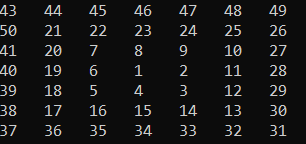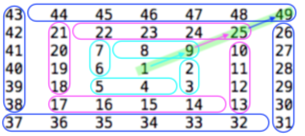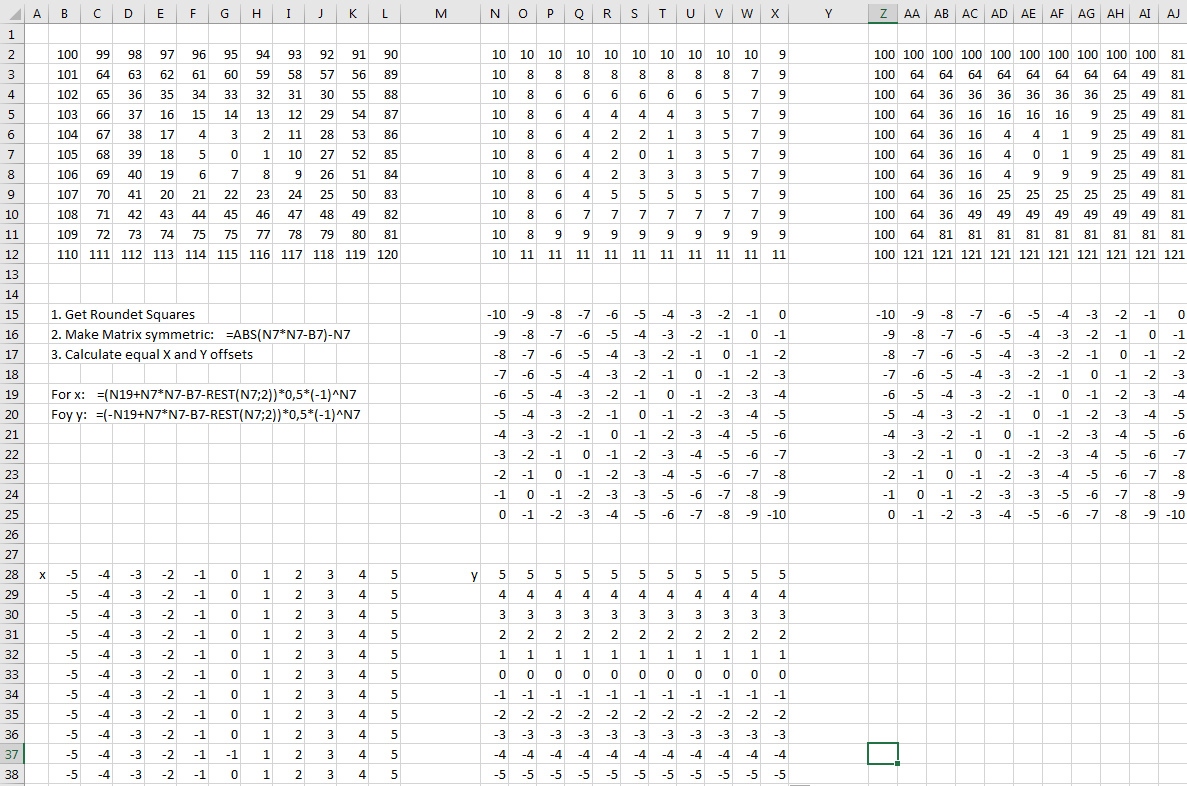从中心以螺旋形式填充矩阵
我最近为我正在做的一个项目做了一个算法。
简单地说,我的项目的一部分需要填写一个矩阵,如何完成它的要求如下:
- Fill the matrix in form of spiral, from the center.
- The size of the matrix must be dynamic, so the spiral can be large or small.
- Every two times a cell of the matrix is filled, //DO STUFF must be executed.最后,我做的代码工作了,这是我最大的努力,我无法对它进行更多的优化,这让我感到有点困扰,因为我不得不使用这么多的ifs,我想知道是否有人可以查看我的代码,看看是否有可能进一步优化它或者进行一些建设性的评论(它很好,但如果它更快一些,因为这个算法将在我的项目中执行几次)。也让其他人可以使用它!
#include <stdio.h>
typedef unsigned short u16_t;
const u16_t size = 7; //<-- CHANGE HERE!!! just odd numbers and bigger than 3
const u16_t maxTimes = 2;
u16_t array_cont[size][size] = { 0 };
u16_t counter = 3, curr = 0;
u16_t endColumn = (size - 1) / 2, endRow = endColumn;
u16_t startColumn = endColumn + 1, startRow = endColumn + 1;
u16_t posLoop = 2, buffer = startColumn, i = 0;
void fillArray() {
if (curr < maxTimes) {
if (posLoop == 0) { //Top
for (i = buffer; i <= startColumn && curr < maxTimes; i++, curr++)
array_cont[endRow][i] = counter++;
if (curr == maxTimes) {
if (i <= startColumn) {
buffer = i;
} else {
buffer = endRow;
startColumn++;
posLoop++;
}
} else {
buffer = endRow;
startColumn++;
posLoop++;
fillArray();
}
} else if (posLoop == 1) { //Right
for (i = buffer; i <= startRow && curr < maxTimes; i++, curr++)
array_cont[i][startColumn] = counter++;
if (curr == maxTimes) {
if (i <= startRow) {
buffer = i;
} else {
buffer = startColumn;
startRow++;
posLoop++;
}
} else {
buffer = startColumn;
startRow++;
posLoop++;
fillArray();
}
} else if (posLoop == 2) { //Bottom
for (i = buffer; i >= endColumn && curr < maxTimes; i--, curr++)
array_cont[startRow][i] = counter++;
if (curr == maxTimes) {
if (i >= endColumn) {
buffer = i;
} else {
buffer = startRow;
endColumn--;
posLoop++;
}
} else {
buffer = startRow;
endColumn--;
posLoop++;
fillArray();
}
} else if (posLoop == 3) { //Left
for (i = buffer; i >= endRow && curr < maxTimes; i--, curr++)
array_cont[i][endColumn] = counter++;
if (curr == maxTimes) {
if (i >= endRow) {
buffer = i;
} else {
buffer = endColumn;
endRow--;
posLoop = 0;
}
} else {
buffer = endColumn;
endRow--;
posLoop = 0;
fillArray();
}
}
}
}
int main(void) {
array_cont[endColumn][endColumn] = 1;
array_cont[endColumn][endColumn + 1] = 2;
//DO STUFF
u16_t max = ((size * size) - 1) / maxTimes;
for (u16_t j = 0; j < max; j++) {
fillArray();
curr = 0;
//DO STUFF
}
//Demostration
for (u16_t x = 0; x < size; x++) {
for (u16_t y = 0; y < size; y++)
printf("%-4d ", array_cont[x][y]);
printf("\n");
}
return 0;
}

回答 2
Stack Overflow用户
发布于 2021-12-27 21:37:51

注意,沿对角线的数字(1,9,25,49)是奇数的平方。这是一个重要的线索,因为它表明矩阵中心的1应该被看作螺旋的末端。
从每个螺旋的末尾开始,x,y坐标应该向上调整,然后向右1调整。然后,通过向下、左、上、右移动相同的量,就可以构造下一层螺旋。
例如,从1的位置开始,向上移动,向右移动(9的位置),然后用以下过程形成一个循环:
move down, and place the 2
move down, and place the 3
move left, and place the 4
move left, and place the 5
etc.因此,代码如下所示:
int size = 7;
int matrix[size][size];
int dy[] = { 1, 0, -1, 0 };
int dx[] = { 0, -1, 0, 1 };
int directionCount = 4;
int ringCount = (size - 1) / 2;
int y = ringCount;
int x = ringCount;
int repeatCount = 0;
int value = 1;
matrix[y][x] = value++;
for (int ring = 0; ring < ringCount; ring++)
{
y--;
x++;
repeatCount += 2;
for (int direction = 0; direction < directionCount; direction++)
for (int repeat = 0; repeat < repeatCount; repeat++)
{
y += dy[direction];
x += dx[direction];
matrix[y][x] = value++;
}
}Stack Overflow用户
发布于 2021-12-28 05:02:40
我已经看到了很多螺旋形的方法。所有这些基本上都是画出来的,沿着一条路走。
但是,你也可以给出一个螺旋的解析计算公式。
因此,没有递归或迭代的解决办法,遵循一条路径或类似的。如果我们有运行数,我们可以直接计算矩阵中的指数。
我将从在一个笛卡尔坐标系中的数学正方向(逆时针方向)的螺旋开始。我们将集中讨论X和Y坐标。
我制作了一个简短的Excel,并由此导出了一些公式。下面是一张简短的图片:

根据要求,我们知道矩阵是二次的。这会让事情变得更简单。更棘手的是,获得矩阵数据的对称性。但有一些简单的公式,从价格,这并不是一个真正的问题。
然后我们可以用一些简单的语句来计算x和y坐标。请参阅下面的长变量名称示例程序,以更好地理解。代码是用一步一步的方法来说明实现的。当然,它可以变得更紧凑。不管怎么说。让我们来看看。
#include <iostream>
#include <cmath>
#include <iomanip>
int main() {
// Show some example values
for (long step{}; step < 81; ++step) {
// Calculate result
const long roundedSquareRoot = std::lround(std::sqrt(step));
const long roundedSquare = roundedSquareRoot * roundedSquareRoot;
const long distance = std::abs(roundedSquare - step) - roundedSquareRoot;
const long rsrIsOdd = (roundedSquareRoot % 2);
const long x = (distance + roundedSquare - step - rsrIsOdd) / (rsrIsOdd ? -2 : 2);
const long y = (-distance + roundedSquare - step - rsrIsOdd) / (rsrIsOdd ? -2 : 2);
// Show ouput
std::cout << "Step:" << std::setw(4) << step << std::setw(3) << x << ' ' << std::setw(3) << y << '\n';
}
}所以,你看,我们真的有一个分析的解决方案。给定任意数,我们可以用公式计算x和y坐标。凉爽的。
获取矩阵中的索引只是添加了一些偏移量。
有了这些知识,我们现在就可以很容易地计算出完整的矩阵。而且,由于根本不需要运行时活动,所以我们可以让编译器来完成这项工作。我们将简单地对每件事使用constexpr函数。
然后编译器将在编译时创建此矩阵。在运行时,什么都不会发生。
请看一个非常紧凑的解决方案:
#include <iostream>
#include <iomanip>
#include <array>
constexpr size_t MatrixSize = 15u;
using MyType = long;
static_assert(MatrixSize > 0 && MatrixSize%2, "Matrix size must be odd and > 0");
constexpr MyType MatrixHalf = MatrixSize / 2;
using Matrix = std::array<std::array<MyType, MatrixSize>, MatrixSize >;
// Some constexpr simple mathematical functions ------------------------------------------------------------------------------
// No need for <cmath>
constexpr MyType myAbs(MyType v) { return v < 0 ? -v : v; }
constexpr double mySqrtRecursive(double x, double c, double p) {return c == p? c: mySqrtRecursive(x, 0.5 * (c + x / c), c); }
constexpr MyType mySqrt(MyType x) {return (MyType)(mySqrtRecursive((double)x,(double)x,0.0)+0.5); }
// Main constexpr function will fill the matrix with a spiral pattern during compile time -------------------------------------
constexpr Matrix fillMatrix() {
Matrix matrix{};
for (int i{}; i < (MatrixSize * MatrixSize); ++i) {
const MyType rsr{ mySqrt(i) }, rs{ rsr * rsr }, d{ myAbs(rs - i) - rsr }, o{ rsr % 2 };
const size_t col{ (size_t)(MatrixHalf +((d + rs - i - o) / (o ? -2 : 2)))};
const size_t row{ (size_t)(MatrixHalf -((-d + rs - i - o) / (o ? -2 : 2)))};
matrix[row][col] = i;
}
return matrix;
}
// This is a compile time constant!
constexpr Matrix matrix = fillMatrix();
// All the above has been done during compile time! -----------------------------------------
int main() {
// Nothing to do. All has beend done at compile time already!
// The matrix is already filled with a spiral pattern
// Just output
for (const auto& row : matrix) {
for (const auto& col : row) std::cout << std::setw(5) << col << ' '; std::cout << '\n';
}
}不同的坐标系或其他螺旋方向可以很容易地适应。
编码愉快。
https://stackoverflow.com/questions/70502661
复制




![SpringBoot之引导类[Application]](https://ask.qcloudimg.com/http-save/yehe-10074098/cc2569f3cb8b8cf44655a773cb5849f9.png)





